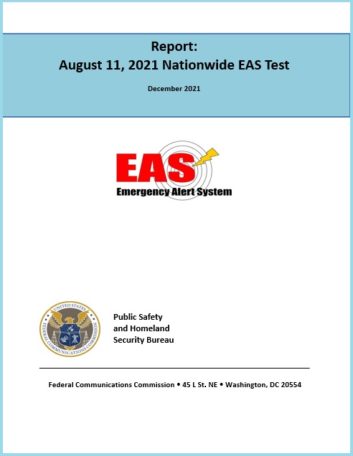 The nationwide test of the Emergency Alert System last August showed improvement over the previous test in 2019, according to the Federal Communications Commission.
The nationwide test of the Emergency Alert System last August showed improvement over the previous test in 2019, according to the Federal Communications Commission.
“Receipt and retransmission rates increased, while reported monitored source complications markedly decreased,” it stated in a new report.
But the commission said technical glitches that did occur highlight the importance of those EAS stations that are monitored by many others.
“It is critically important that those EAS participants that are widely monitored use testing to ensure their EAS equipment is in reliable working order.”
Some key data points from the report:
The national test message reached 89.3% of EAS participants, up from 82.5% two years ago. Its overall retransmission success rate was 87.1%, up from 79.8%. Seven Primary Entry Point stations experienced technical complications, fewer than last time. And test participants reported roughly half as many complications with receipt and retransmission this time around.
The FCC concluded: “As observed in 2019, the system would largely perform as designed, and it would reach the vast majority of the public, if activated without the availability of the internet.”
That last phrase is important because this particular test — performed by the Federal Emergency Management Agency in coordination with the FCC — used only the broadcast-based distribution system, the so-called “EAS daisy chain,” and did not involve the internet-based IPAWS system. The goal was to check the system’s capability to deliver messages in event that the internet path was not available.
Digging into details
The FCC said the large majority of EAS participants reported successful receipt and retransmission. There are more than 25,000 EAS participants, including radio and TV stations, cable TV systems, direct broadcast satellite, SiriusXM, digital audio broadcasting systems and wireline video systems.
Where problems did arise, they involved equipment configuration, performance issues, audio quality, alerting source issues and clock errors. Audio quality issues were the most frequently reported on receipt. The test “shed light on challenges that impeded the ability of some EAS participants to receive and/or retransmit the test alert.”
There are 76 Primary Entry Point stations in the country; seven reported technical complications this time compared to 12 in 2019.
“We believe it is reasonable to infer that these improvements in PEP stations’ performance significantly contributed to the marked increases in receipt and retransmission rates,” the FCC concluded. “Additionally … many 2021 PEP complications resulted in low audio rather than total failure to transmit the nationwide test.”
The PEP stations with problems were in North Carolina, Michigan, Kentucky, Florida, Virginia and American Samoa. Premiere Networks, a satellite-based PEP station that is monitored in several states, also transmitted no audio.
Of those seven PEPs, three relayed low audio; two relayed no audio. One PEP was hit by lightning immediately prior to the test, and another had a communications issue and did not receive the test.
FEMA told the FCC it is taking measures to improve PEP performance. “In particular, FEMA is continuing its work with SECCs in several states to conduct state-level tests on a monthly basis and station-level tests on a weekly basis through the PEP stations.”
Among non-PEP stations, the number of reported problems “significantly declined.”
SECC representatives in New Jersey, Pennsylvania, Georgia, Kansas and Washington did report some local broadcast distribution chain issues.
In New Jersey and Pennsylvania, the issues were specific to one widely monitored source in each state that experienced equipment configuration issues on test day. “Each station engineer reports to have fixed the issue.”
In Georgia, the southern portion of the state relies on intermediary sources like local primaries and state relays to receive the test message. On test day, the FCC said, a state relay experienced a technical issue that disrupted transmission of the alert to parts of southern Georgia. The SECC reports that the issue has been fixed.
In Kansas, one widely monitored EAS participant received the alert from Premiere Networks and as a result retransmitted an alert that lacked audio. This participant was monitored by 41 others, of which 32 reported also retransmitting an alert that lacked audio.
In Washington, the SECC reported that several stations in the eastern part of the state received and retransmitted an alert message with low, and at times, no audio.
Some other findings:
-The overall participation rate of 75.3% was down from 78.6% in 2019. Radio broadcasters had a participation rate of 79.9%, down from 82%.
-The number of stations that apparently don’t know what participant type they are has increased. (Participant types include national primary, state primary, state relay and local primaries 1 and 2.) “Test participants need to better understand their role in the EAS and there is still room for improvement in this regard,” the FCC found.
-There were 2,550 test participants on receipt and 1,506 on retransmission that said their stations did not receive the alert due to audio quality complications. “Many test participants reported background noise, only tones and no message, and/or unintelligible audio.”
-There were 389 test participants that reported equipment performance issues on receipt and 565 on retransmission involving non-working equipment that required returning equipment to the manufacturer. “Participants cited that the equipment simply was out for repair, failed during the test, was missing or malfunctioned.”
-Participation by low-power broadcasters is an area of concern. Low-power stations are required to broadcast the alert, though not required to have equipment capable of generating the EAS codes and Attention Signal. The commission had made an effort to improve low-power radio and TV participation, reaching out to offer targeted resources including a webinar just for them. Yet LPFM participation in the test was 49.5%, much lower than that of radio overall and down from 2019’s LPFM participation rate of 55.9%. Similarly, LPTV participation (47.4%) was lower than that of TV broadcasters overall and lower than 2019’s participation rate. Of the 3,700 or so radio broadcasters that were expected to file but failed to do so, more than 28% were LPFMs; and of the 1,500 or so television broadcasters that were expected to file but didn’t, almost 70% were LPTVs.
Next steps
For more details, see the full EAS report.
The commission reminded EAS participants that they can reduce complications by redundant monitoring. “We continue to emphasize the importance of multiple monitoring sources as required by our rules. We also recommend that stations located far from PEP stations consider the viability, technically and otherwise, of satellite sources of the broadcast alert, such as NPR Squawk Channel, Premiere Networks and SiriusXM.”
The FCC also noted that it has launched a proceeding to improve the accessibility of visual content for alerts that are distributed via the EAS protocol and to explore other possible changes in the EAS system. “We encourage parties with an interest in these issues to submit comments in this proceeding in PS Docket 15-94.”
It also said it will continue to tweak the online forms that stations and others must fill out after a national test. It will explore how to use state EAS plan data to streamline and improve the accuracy of those ETRS filings “such as by educating EAS participants of their EAS designations and better ensuring that they monitor their assigned alerting sources.”
It said it will work with state emergency communications committees to help ensure that state EAS plans, which must be updated by July 5, 2022, assign monitoring sources to participants that ensure redundancy and coverage for areas that have difficulty receiving broadcast signals.
And “EAS participants can address some deficiencies with more education, continued training and improved communication with other broadcasters and their SECC to better understand their role and obligations as a participant in the EAS,” the FCC wrote.
“We encourage EAS participants to use this process to ensure their EAS equipment is in reliable working order, confirm that they are monitoring appropriate sources, and verify that the audio level of the alert is correct. Specifically, it is critically important that those EAS participants that are widely monitored use testing to ensure their EAS equipment is in reliable working order.”
It said participants that fail to receive an alert or note any issues during a scheduled test “should work swiftly and closely with their SECC to identify why and take all necessary steps for corrective action.”
The bureau separately released a report on the nationwide test of Wireless Emergency Alerts that was conducted the same day. It said the WEA test “demonstrates that, on the whole, WEA generally is performing reliably but there is room for improvement.” Many mobile devices erroneously received a duplicate nationwide WEA test message, it wrote, “and there may be opportunities to improve WEA’s reliability.” (Read the full WEA report.)







